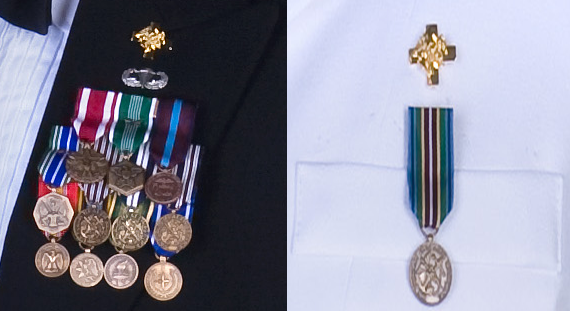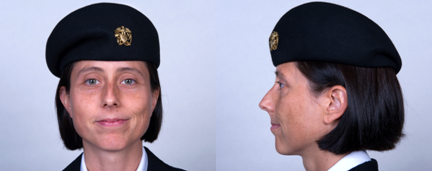|
Commissioned Corps of the U.S. Public Health Service (Corps) Uniforms
|
Submitted by LCDR Kyle Lyons, USPHS, Uniform Policy Coordinator,
Workforce Policy and Plans Division, Office of Commissioned Corps Force Management
Please note:Any uniform questions can be sent electronically to LCDR Lyons at
james.lyons@hhs.gov or 240-453-6098
|
|
This month we have received numerous questions on the topic of covered or uncovered in a duty station. First of all, a covered area is an area in which the cover is not worn (e.g., indoors, at sea on an underway ship, or on a flight line). An uncovered area is an area in which the cover is worn (e.g., parking lot, sidewalk, or any area in which routine interaction with the public or other Servicemembers (including officers of the Commissioned Corps of the U.S. Public Health Service) is likely.
According to Commissioned Corps Issuance (CCI) CC26.3.1, “Uniforms and Appearance,” dated 02 February 2010, Section 8-3 states, “LUAs (Local Uniform Authorities) may determine those areas, such as a specific area of connected or adjacent buildings and grounds not including parking areas, which officers may transit out-of-doors but consider themselves indoors for purposes of meeting uniform requirements and/or extending service courtesy such as saluting. However, entire areas, such as but not limited to: campuses, complexes, installations, institutions, research facilities or parking areas/decks, in which interaction with the general public or other uniformed service members is likely, are not permitted to be considered covered.” More simply put, if you look up and see the sky, look to your left, right, front or back and there is no wall, or the structure you are in is not permanent (e.g., tent, hangar, or overhang), and you may interact or see another person, then more than likely you should be wearing your cover.
As with everything, there are exceptions, and there is no means to address every “What if . . .” scenario in policy. Instances such as eating at an outdoor café or restaurant, working on an active flight line, riding a bike, or attending/participating a religious ceremony, doesn’t normally require the wear of a cover. However, attending a military graduation ceremony inside an aircraft hangar, an outdoor promotion ceremony, or providing troop security inside a barracks or dormitory (considered under arms, even though sometimes not actually carrying a weapon) might. Common sense and situational awareness should always prevail. If you are in a joint services event and everyone else is/isn’t wearing a cover, then you should do the same. It is always better to have your cover and not need it than to not have your cover and need it.
|
Questions and Answers
|
Q.
|
I am a Lieutenant Commander and I will be attending a graduation at a military academy. One of the functions calls for the Mess Dress uniform (or service equivalent). What does that mean? What is our equivalent?
|
|
A.
|
The Mess Dress uniform is a land service term for the Dinner Dress Jacket uniform or Dinner Dress uniform. Per policy, CC26.3.4, “Uniforms for Male Officers,” and CC26.3.5, “Uniforms for Female Officers,” for officers at Lieutenant Commander (O-4) and above, the prescribable uniform is the Dinner Dress Blue or White Jacket, while it is optional for Lieutenants (O-3) and below. For Lieutenants (O-3) and below, the Dinner Dress Blue or White uniform is prescribed. It is better to always bring a pair of white gloves with you, as they may or may not be required. The Dinner Dress with “Jacket” qualifier is the more formal of the two Dinner Dress type uniforms.
A reminder: Mini-medals and badges are worn on the lapel, not beside or behind the lapel on the Dinner Dress Blue or White Jacket. For the Dinner Dress Blue or White uniform, the mini-medals are placed in the normal location on the left chest above the pocket tab/flap.
| 
|
|
Q.
|
When attaching my garrison cap under my belt for wear, how it is supposed to be placed?
|
|
A.
|
Depending on the side worn on the hip, that determines which side is showing. If wearing the garrison on the right hip, the rank should be showing. Conversely, if worn on the left hip, the miniature cap device should be showing. The opening for your head should never be facing forward. Also, there is no regulation or requirement as to which side to place the garrison cap when wearing on the hip.
The garrison cap is to be placed under the belt and hang freely. It should be placed in the area above or near the side pockets. It should not be looped or draped over the belt/trousers top. It also should not be carried/stowed under epaulettes of the windbreaker jacket or under shoulder boards/marks. This may be done in the land services, but this is not authorized in the Corps.
|
|
Q.
|
In the uniform policies, what does “worn squarely on the head” mean?
|
|
A.
|
Combination covers are worn approximately ½ inch above the eyebrows, and are worn not to show the forehead.
Garrison caps are worn approximately ½ inch above the eyebrows and hair is not visible from the front. The crown of the cap is worn centered on the top of the head, fore and aft, between the eyebrows.
Command Ball cap and the Battle Dress Uniform (BDU) cover is worn approximately ½ inch above the ears and bottom edge parallel to the deck.
Of course, every head is different and measurements may be slightly different for each person, as to not cover the eyes or create a hazard.
Covers should never be worn flattened on the head or be as low/tight on the head as to create a “bulge” through the top of the material.
Crown material of the garrison cap should be as closed as possible.
Covers should not be “cocked” to either side, or worn “Gomer Pyle” style, tilted back on the head, exposing a large portion of the forehead.
A simple method to align ones cover is to place the cover upon the head and adjust the front portion of the cover using the index and middle finger and first knuckle of either hand. The first knuckle of the index finger is placed against the tip of your nose and the tip of the index finger barely touches the bottom front edge or bill of the associated cover.
|
|
Q.
|
What is the correct way to wear the female beret?
|
|
A.
|
First of all, the Corps and Navy female beret is semi-rigid (non-collapsible) and is not the same as the Army style flat or collapsible beret. It is not recommended to flatten or roll your beret in a manner similar to what Army personnel do, as this will damage the beret and therefore make it unserviceable. The beret should be “smooth” and pill-free, it should also not have dimples and divots in the material.
According to CC26.3.5, “Uniforms for Female Officers,” “Wear the beret toward the front of the head, approximately 3/4 inch from the forehead hairline, and tilted slightly to the right. Align miniature-sized cap device insignia above the left eye.” If you have a receding hairline, you do not wear the beret further back on the head. In general, this is what proper wear should look like:
|

|
|
|


